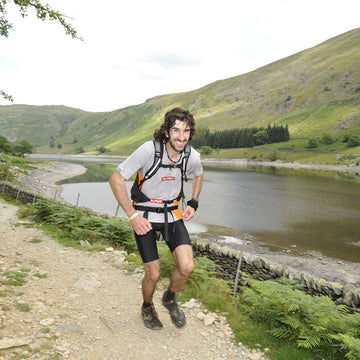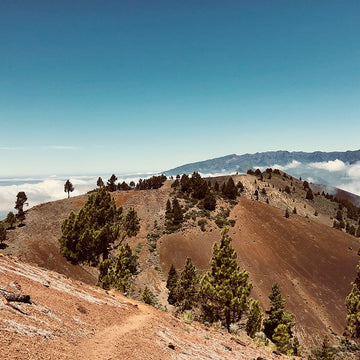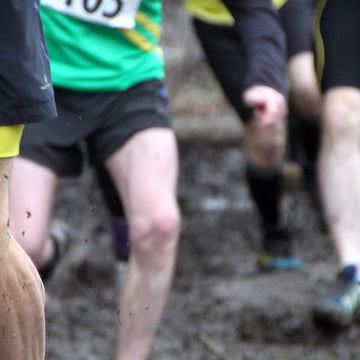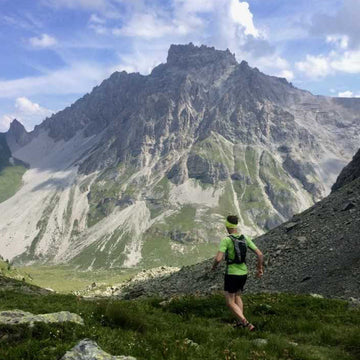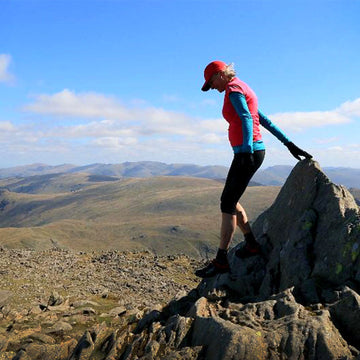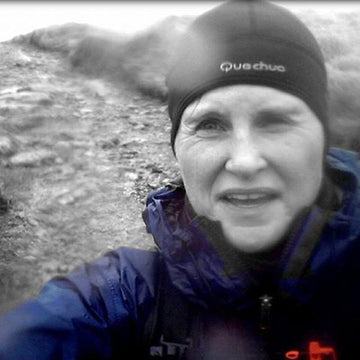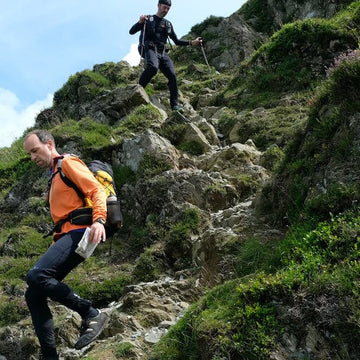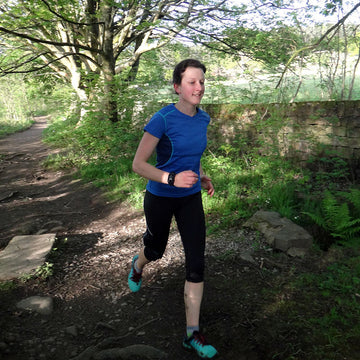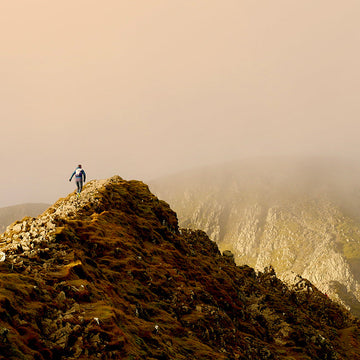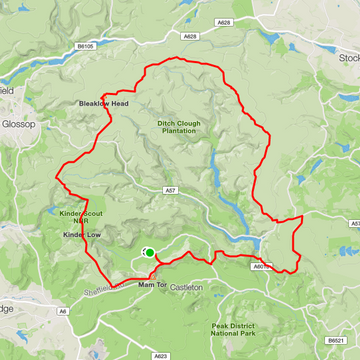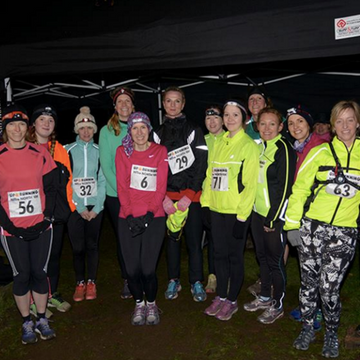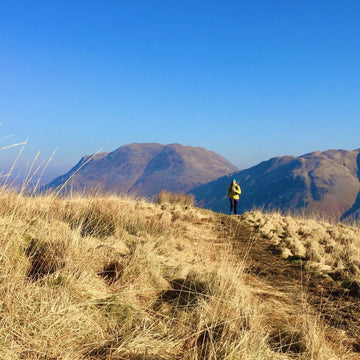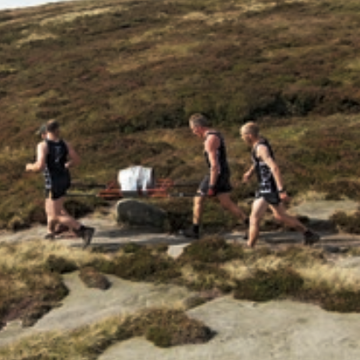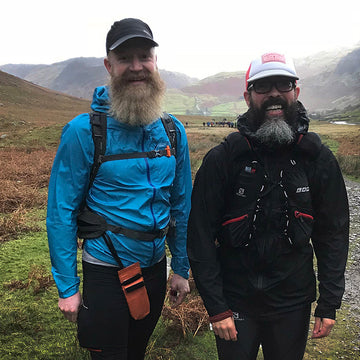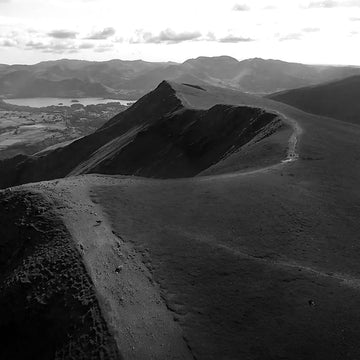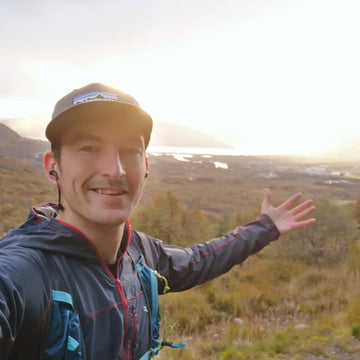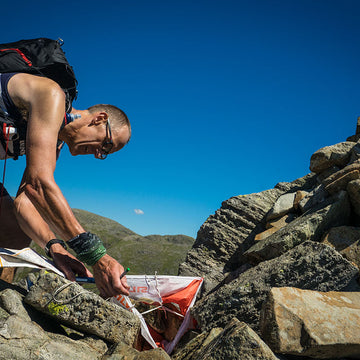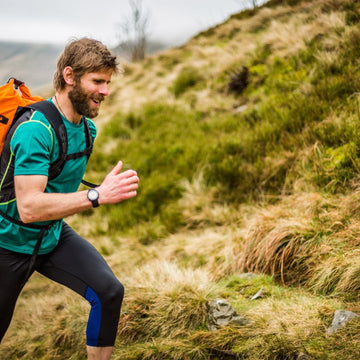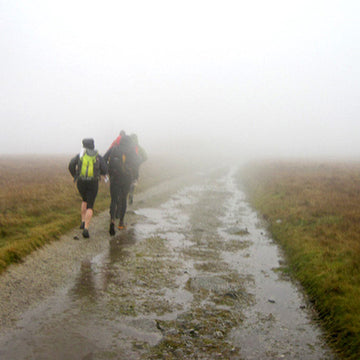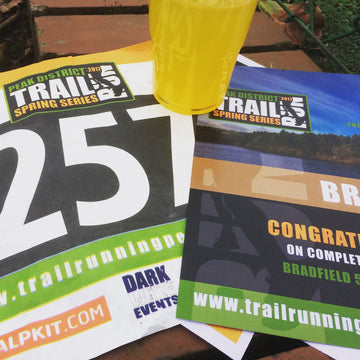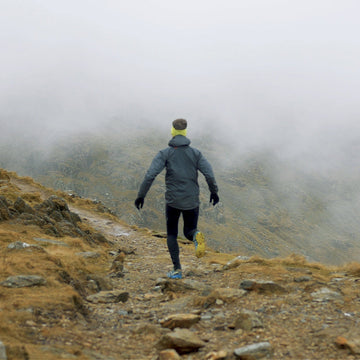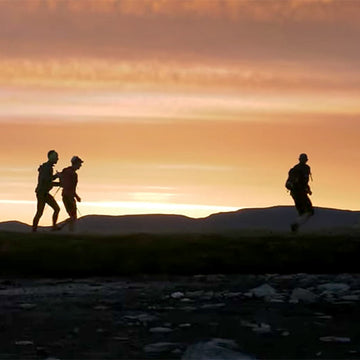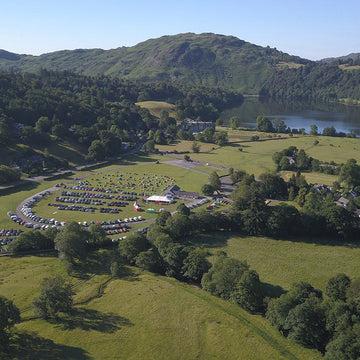
The Spine Race and Other Mishaps: Challenges and lessons from extreme endurance races.
What you are about to read is an exclusive extract from the book "In it for the Long Run" by Damian Hall. To see more books we love and books that caught our eye, check out our bookshelf.
‘I didn’t know where I was, what I was doing.’
I had a magazine commission to run a sub-three-hour marathon two weeks after my first 100-mile run. 2013’s inaugural Bournemouth Marathon started well enough, with natural exuberance and sugary drinks pushing me along at the requisite six-and-a-half-minute mile pace. With an hour gone I was still on target, but the struggle was getting real. On a secluded stretch I spied a fellow runner caught short and watering the plants. He apologised, needlessly, and we laughed it off. But as we ran together I realised it was the inappropriately named Jez Bragg, the UK’s top ultrarunner. He’d won UTMB and recently sea record for a hugely inspiring fifty-three-day run down the length of New Zealand.
I was starstruck and behaved like the obsessive fan in I’m Alan Partridge, peppering him with questions. But after he ducked off to the toilet again, this time in more formal facilities, I let him run in peace.
‘I’m going to beat Jez Bragg!’ I said to myself in disbelief. I didn’t, of course. At about twenty-two miles, Jez (who, an obsessive fan would know, also came to ultramarathons from a hiking background and clocked the same debut marathon time as me) sauntered past, wishing me luck, but further denting motivation.
Talking of incentives, I wouldn’t get paid for the story if I didn’t run a sub-three-hour marathon. That’s perhaps why I haven’t DNFed an ultramarathon yet. Most of my early challenges and races were magazine stories, where sometimes a photographer also might not get paid if we didn’t achieve what we’d proposed. So I got it done.
Running 261 miles takes some motivation too (Incidentally, the Pennine Way is officially 268 miles, but that includes some optional detours, which the Spine Race doesn’t take, though Mike Hartley included the 2-5 mile out and back to the Cheviot summit. So both the Spine and Mike’s record are closer to 261).
When I first heard of the Spine Race, which calls itself ‘Britain’s most brutal race’, a single stage format (so the clock is always ticking) along the Pennine Way in January, it sounded like wonderful insanity, and therefore compelling. 'It’s almost perfect in its cruelty', said race cofounder Scott Gilmour. With my emotional and professional investment in the legendary trail and a new but intense curiosity about distance running and how far it was possible to go, the idea didn’t just catch my attention but grabbed it in its jaws and wouldn’t let go.
I remembered occasional Twitter updates from the first race in 2012: so and so had arrived at the checkpoint in Hawes. I’d go to work, come home, eat dinner and just before bed learn so and so had arrived in Alston. The next day Bellingham. It went on and on for up to seven days. All that time in darkness and biblical weather. All that suffering. Would anyone make it to Kirk Yetholm? From eleven intrepid starters that first year, just three got to the finish.
The second year saw the start list jump to thirty. Again, I followed the tweets with my imagination aflame. What were those people going through? Was it anything like Luke Skywalker lost on Hoth or Scott struggling in the Antarctic? This time fourteen people made it to the finish.
I pored avidly over Spiners’ blogs till I knew their stories by heart. There were tales of frozen water bottles, trench foot, hallucinations. ‘I didn’t know where I was, what I was doing’, David Lee wrote of his desperate sleep deprivation. ‘I didn’t know I was taking part in this event’. There was something about the next level voluntary torture, playing a game of survival, that fascinated me. It seemed both totally unnecessary and yet heroic. It was so compelling as a follower. What must it be like as a runner? Could I possibly hack it?
Sign up for the things that scare you, right?
My training plan suggested back-to-back to back forty-mile runs, which I know now is pretty idiotic. But I did it, just about, via some 4 a.m. alarms. I was invited out for Christmas drinks by some colleagues at Future Publishing. It was agonising to say no thanks, but the running was more important. Fatigue, I thought, validated the idea I was training well. Like the Grinch, the Spine kind of ruined Christmas. I was too fearful of the challenge ahead, too obsessed with kit and training to relax with family.
After two experimental years, the third Spine Race in 2014 mushroomed to a start list of seventy-five. Online tracking was introduced, primarily for safety. But it was excellent marketing too and friends would later tell me they spent long hours watching my dot, or ‘Daddy’s wiggly line’ as my two-year-old daughter called it (and it did get very wiggly).
Competitors are allowed seven days to travel the Pennine Way. There are five main checkpoints, roughly every twenty-four hours, providing hot meals, medical support and a place to sleep (sometimes on a wooden floor), though athletes must otherwise be self-sufficient, carrying a huge mandatory kit upwards of five kilograms. You’re allowed a resupply or drop bag that’s ferried on ahead of you. In Edale the night before the race the other contestants looked calm but the briefing was mostly about how to avoid dying.
We set off on a cloudy morning but with sunshine forecast – at least Charlie Sproson thought so: my future friend is still the only person to start the Spine Race in shorts. We ran across snow and ‘treacherous icy flagstones, through energy sapping mud and over fields that had morphed into lakes during one of the wettest Januarys on record,’ Nick Mead would write on the Guardian’s website. Conditions were causing broken trekking poles, hips and wrists, with Mark Hines, author of several books on ultramarathons, an early DNF. I ran all of the first day with Nick, who had his brother supporting him in a campervan (as was allowed at the time).
I got less than three hours’ sleep in my tent on a ffffreezing Ickornshaw Moor. At lunchtime I bought a large slab of lemon drizzle cake in Malham, possibly the best decision I made in the race.
The weather deteriorated – ‘Absolutely horrendous conditions’, tweeted Scott Gilmour – and the rocky Penyghent became an icy scramble in the dark. I was topographically confused when Mark ‘Bez’ Berry and David Carr, who I’d shared my cake with earlier, caught up with me. They were great company, but I was holding them up. However, the two saints insisted on sticking with me. They either thought I wasn’t safe on my own or hoped I had more cake. There were hours of stinging rain and aggressive wind, sore feet on icy rocks, deep weariness and, when we finally got to Hawes at 11 p.m., tears.
Eight grown men openly cried at the checkpoint that night (no women did, it was pointed out to me later). The village hall looked like a disaster zone, with bags, kit and traumatised faces everywhere. ‘You fucking well will finish this race!’ said the Spine’s Mother Superior, Nici Griffin, which was what I needed. Well, that, dry socks, a gallon of tea and some sleep.
I tried to grab some on a wooden floor, but didn’t get much. I heard Nici on the phone. ‘Does anyone speak any Spanish?’ she yelled. It was 2013 race winner Eugeni Roselló Solé calling in a DNF from the Tan Hill Inn with hypothermia. The previous year he’d finished with footballs of ice attached to his shoes. Charlie would DNF here; Nick had DNFed at Penyghent. In my emotional and fatigued state, these bits of news felt catastrophic.
I left as daylight broke, inside the top ten. I felt shellshocked; it was every bit as hard as I had fantasised. The afternoon sun splashed across the moors and I got my mojo back after a big bag of chips from the lonely Tan Hill Inn. I caught glimpses of Andy Mouncey behind and though company felt inviting, I wasn’t just thinking about completing now. I was starting to cautiously think about competing. So I didn’t let him catch up.
I left the Middleton in Teesdale checkpoint, just over halfway, at about 3 a.m., under magical falling snowflakes. I was surprised to realise I felt inexplicably amazing. Sure, I had generic complaints and discomforts and kinesiology tape all over my feet. But hunched up in my waterproof I felt bizarrely happy. I was having an adventure. I was surviving.
The sky lightened as I hit Hick Cup Nick, a huge glaciated canyon and one of the greatest views in England. On the way down to Dufton, I felt an almost alarming level of happiness and surreal euphoria. These were extinguished by the bastard named Cross Fell. The highest and officially coldest place in England outside the Lake District was plastered in snow and the path kept vanishing. In Greg’s Hut I was plied with noodles, chocolate and good cheer by Spine legends John Bamber and Paul Shorrock. I was learning that it’s the amazing staff and volunteers who give this event such a special atmosphere.
I left checkpoint four, near Alston (176 miles in), at 1 a.m. Till then I had physical fatigue; from there I was mentally fatigued too. I had no idea what day it was and charging my phone seemed really complicated. I thought I saw ultra celebs Mimi Anderson (also a DNF) and Mark Hines there. But I was losing trust in what my eyes were telling me.
That weird and delicious euphoria returned just in time for the tortuous ups and downs of Hadrian’s Wall. When a lady approached across a field, offering tea and a bacon roll, I thought I must be hallucinating. The amazing woman fed every Spiner that year and has done so every year since, despite being nothing officially to do with the race. Locals gave me unsolicited food and drink at others times too. There’s something about people striving to do extraordinary/ridiculous things that attracts others. Perhaps it’s the same reason Romans went to the Colosseum to witness gladiators having their arm munched on by a lion. But perhaps there are still lots of kind people in the world.
Towards the end of the penultimate day, unbelievably I was gaining on third place. Instead of sleeping at the final checkpoint in Bellingham, after a plate of pasta and a couple of teas, I decided to give chase. At first, I flew. But then a lethargy bomb went off. Sleep deprivation conspired with a huge calorie deficit to whack me over the head with a giant mallet. I tried a power nap three times. But it was too cold and a little voice in my head suggested I might never wake up again. So I trudged pitifully onwards, staggering like Skywalker on Hoth, fighting against the force.
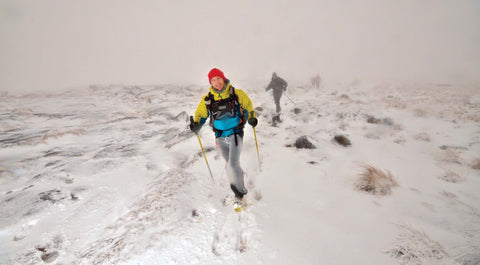
© Summit Fever Media
Up on the Cheviots, I saw huge red Chinese lanterns being set off from a nearby hilltop and began to follow them. But when I checked my GPS, I was way off route. Embarrassing enough when thousands may be watching your dot online, but even more so if you’ve written a guidebook for the very trail you’re not on. I trudged round in confused boggy circles till grey daylight finally arrived. Ahead of me, rocks turned into people and weird serpentine shapes, only to disappear again (I hadn’t yet twigged that the lanterns had never existed). I felt like I hadn’t seen another human for days.
In an emergency hut I stopped for a brew, and woke with my head sliding down the wall towards the flames of my gas cooker. I had no water anyway. A combination of ibuprofen and paracetamol wasn’t preventing my knee from hurting. Or my shins. Or hips. I was a wreck; I cried and cried out loud. It was a lovely day. But the fatigue, the emotional rawness, the desperation for it to be over, were almost overwhelming.
On the afternoon of day six, when I finally reached the road near Kirk Yetholm, a local runner joined me, saying ‘I wanted to see what people who do the Spine look like’ (Neil Rutherford would later become a Spiner too�) After kissing the wall of the Border Hotel and getting a medal from Mark Hines, I was bought a pint of orange and lemonade (alcohol didn’t seem wise) and a cake.
It felt like I had some kind of traumatic stress. It had been a real adventure (albeit with a tangible safety net) that had put me through the emotional shredder, tested me, frightened me, humbled me, reduced me to tears, but ultimately made me feel alive. Exactly what I wanted. The sense of satisfaction was huge.
That year thirty of the seventy-five starters finished the race. ‘After 127 hours and 11 minutes, with a lot of luck and many moments of generous help from others, I finished the 2014 Spine Race, in a very surprising fourth place,’ I wrote on the Telegraph website. ‘I struggle, even weeks later, to describe just how good that feeling is. And why, exactly, I’m desperate to do it all again.’
‘[The Spine] isn’t just a foot race,’ I wrote on the Guardian’s running blog. ‘For some, it’s an obsession. I struggle to contain and explain the effect the Spine has on me. It’s a combination of three of my greatest passions: the Pennine Way, distance running and getting unrecognisably muddy. Almost all of us need more adventure, more wildness more exercise, more bogs in our lives. And there are few better ways of getting all than the brilliant Spine Race.
‘Above all, it’s that immense sense of freedom, powerful sense of mission, glorious feeling of being in wild, rugged and remote places with likeminded people, high on endorphins and too many caffeine gels and wonderful, rare simplicity of days that I’ll enjoy. Swapping screens and bleeping technology for moody moorlands, enigmatic rock formations and melodramatic skies, for a whole magnificent week.’
I couldn’t run for several weeks afterwards, as the tendons around the front of my ankles and shins were angry. I went down a T-shirt size, from medium to small. I had disgusting night sweats, jumping out of bed in the middle of the night to sort out my kit in a panic. My big toe has been weird ever since and rebels against the idea of having a toenail. When any race or challenge gets hurty, I simply ask, ‘Is it as hard as that first Spine Race? Nope? Well, crack on then, you whinging wussbag!’
Something about it seemed to suit me. The race psychologist (I’ve never done another race that has a psychologist on the staff) Dr Fiona Beddoes Jones thought the key skill for those who did well was their adaptability. She also thought my sense of humour had helped. Which would be a first.
I also felt the challenge had tapped more into my experience as a trekker than as a runner. The simple things, really: getting calories in (even if I didn’t always get it right), staying warm (staying dry is a pipedream), foot care (I only had one small blister), putting up with stuff (chafing in the bath suit area) and just generally looking after yourself. Hill experience was much more valuable than knowing what my VO2max was. When the Spine bubble burst and post-adventure blues hit hard, the only cure was to sign up again.

Finishing the 2015 Spine Race, with Beth Pascall, Mark Townsend, Matt Neale and Tim Laney. © Summit Fever Media
* * *
Maybe my second full season of ultrarunning was always going to be a difficult second album. But nothing else in 2014 went as hoped. I had my first disappointing race and attempted my first running challenge, also unsuccessful. Our second child, a son, was born in April. Which was unspeakably amazing, but inevitably affected my training. I’m not blaming him exactly. But I guess I sort of am.
The nohtaraM nodnoL (see what they did there?) was one of my favourite ever runs, though. Organised via a Facebook group, around forty runners met near Big Ben at 4 a.m. on the morning of the London Marathon, to run the route backwards. A brilliant combination of anarchy and fun, finished at the race’s ‘start’ not long before the slightly more popular version kicked off.
Around then I read about Steve Way in the Guardian, who went from a sixteen-stone, twenty-a-day smoker to running the marathon for England at the Commonwealth Games and breaking the GB 100krecord, both at the age of forty. At thirty-eight that felt inspiring. A close friend also died unexpectedly after being hit by a car while walking on a pavement. Life is short.
Lakeland 50 is a popular fifty-mile race in the Lake District. Despite the uneven playing field of an unmarked course, the race doubled as a rare, official trial for the GB Trail Team, which attracted the country’s top ultrarunners. The men’s line up included GB ultrarunners Marcus Scotney, Kim Collison and Lee Kemp, plus Danny Kendall (known for his impressive exploits at Marathon des Sables) and Stuart Mills (known for winning Lakeland 100 twice and his long but compelling blogs). After fourth place at the Spine and third at my first 100miler, how would I do against the UK’s best?
I really hadn’t trained much. I remember a rare twenty-mile bimble being so tiring I stumbled into a pub mid-run, desperate for a pint of lemonade. But I’d grown in confidence and there was a small idiotic part of me saying, ‘You did well at the Spine and that was 260 miles – how hard can a good result at just fifty miles be?’ Very hard, it turns out. Comparing a 260mile race with a fifty-mile race is like comparing being repeatedly run over by a ten-tonne truck at two miles per hour to being attacked by a madman with a chainsaw. They both hurt a lot. But in very different ways.
At the start I cockily told my good friend, fellow Bath Bat and then Lakeland100 recordholder Lizzie Wraith my training hadn’t been great but I planned to ‘go out hard and hold on’. I should have paid more attention to her raised eyebrows. Both the weather and early pace (six-and-a-quarter-minute miles) at the front were scorching. I idiotically kept Scotney and Kendall in my sights for three miles. Then I bonked. Hard. I walked for a bit in embarrassment, while more sensible runners shot past, including my Bats mates Lizzie and Matt Maynard, who would place second and eighth.
I recovered to place fifteenth. Hardly a disaster, but I was nearly two hours behind the winner Collison. It was a blow to my ego and a useful reminder of how wonderfully humbling ultramarathons can be. After my first disappointing race experience, my thoughts turned for the first time to attempting an established ultradistance challenge.
The Bats were always telling stories about mirth some mishaps on ‘the Bob’ and these standalone challenges seemed to have a special aura. I briefly considered a Ramsay Round, but it seemed too daunting. Instead, I fixed my sights on the South Wales Traverse. The seventy-three-mile, thirty-one summit, 18,000 foot vert challenge in the Brecon Beacons is the southern Britain equivalent to the Bob Graham, according to Wikipedia and most folk around here, anyway. Alex Copping joined me in surprisingly cold August clag at the start, a small layby on a remote road, at 4.20 a.m.
My first undoing was navigation. Map reading has never been my forte– I’m too impetuous and enjoy getting topographically confused to the extent it’s often wilful. I didn’t know the Beacons at all and the terrain soon had me despairing. Paths and trods were intermittent or non-existent, while rocks, tussocks and bogs all mocked me. It was fellrunning (i.e. there’s no path) and I wasn’t a fell runner. One minute you’re leaping over a stream or bog that looks like it could swallow you whole, the next scrambling over rocks, or tumbling down a grassy slope so steep you wouldn’t dare sledge it. This isn’t running in the conventional sense. It’s something much more fun (even if you don’t always agree at the time).
As I reached the Storey Arms activity centre at midday, the first twenty-four miles had taken eight hours. I was still on course for twenty-three hour finish, but every stage had been slower than scheduled, and I had to prance about for Jon, the photographer (who’d also been volunteered as road crew), for a magazine story.
This was my first experience of running to a schedule. You’re a slave to a cruel master. Yes, you helped create that master. But you did it in the comfort of your warm, well it home, without any real knowledge of what the terrain is really like and when you were listening to the Top Gun soundtrack (legally valid mitigating circumstances). You start to hate the schedule. You’re always underperforming; it’s permanently unimpressed.
It was 8 p.m. when I left Llangynidr, with Jon warning of a superbog on Waun Fach which once needed two men to rescue him. I needed to make up sixty minutes to finish under twenty-four hours. Dwindling sunlight found me on a wonderful long ridge in the Black Mountains Under a pinky yellow sky and above a plateau, I tottered along a clear trail, with waves of peaks either side, all exclusively mine. I felt free, happy and alive. And then it all went wrong (again).
Darkness isn’t conducive to good navigation or fast running, and on the dreaded Waun Fach my head torch battery dwindled to almost nothing, colluding with fog to make visibility pathetic. It was boggy, tussocky, a labyrinth of deep channels (there’s a good path up there now). My feet found air and I faceplanted into a bog, taking the map with me. At least I had a GPS. Phew! Then that died.
I was alone in the dark, lost in a mountaintop superbog, with almost no light. I wasn’t really enjoying it any more.
I was worried about my torch dying completely before I could locate my crew in Mynydd Du Forest, so I wasn’t especially diligent about reaching the summit of Pentwynmawr. Which is my way of saying, I knew I probably hadn’t. But I didn’t care. More bushwhacking and a disagreement with a thicket of tall stingers, which on my sore legs feltlike shards of glass, were the last straw. I was going to quit. Jon and Alex would be pleased, I reasoned. We could all go home. Besides, I was out of batteries, so it wouldn’t be safe, would it, to carry on?
It was about 11 p.m. when I finally reached my crew. I didn’t directly say I was quitting. But I suggested ‘some alternatives’ to continuing, such a not continuing right now and instead getting some kip somewhere, then finishing it off in the morning (so we would still have a magazine story of sorts). Or perhaps next week? Next year, then?
Their response was both disappointing (at the time) and perfect (in retrospect). Instead of calling me a big Jessie, as Alex should have, he asked what the weather was like on the tops. ‘Really good now, a big moon, almost no wind.’ How were my legs? ‘Pretty good.’ What did I want to eat? ‘An apple and a sausage roll would be amazing. Oh wow, thanks.’ I needed batteries? Here you go. Drat I had no excuses.
My mojo returned briefly. But somewhere after 1 a.m.it buggered off again. Gels failed to defibrillate me and I was hiking flat sections. I realised I might have gone around Lord Hereford’s Knob (which didn’t register the juvenile titter it normally would) rather than over it. But I didn’t care. It seemed an age till I reached snoozing Alex and Jon at the Gospel Pass after 2 a.m. With some eight miles to go, I’d assumed sub-twenty-four hours wasn’t possible, but I might as well finish. Alex joined me for the last leg in the mist, but I could barely keep up. I tried desperately to stay in sight of the two luminous stripes on his leggings. After a while I asked, ‘Alex, what time is it?’
‘3.20 a.m.’
‘We’ve got an hour!’
Holy cowpat, Batman! There was still hope. I felt as fresh as an out-of-date yoghurt. But in a situation that would give me déjà vu six years later, we were in a race against the clock, in the dark, on the Offa’s Dyke National Trail.
With less than three kilometres to go, we were searching despairingly for the crucial turning to take us off the ridge and down to Llanthony’s twelfth-century ruined abbey. We found one. But the GPS said we weren’t there yet. Should we play it safe or gamble? We gambled (obvs). We hammered it downhill, a knee-juddering descent of several hundred metres, spying the lights of the abbey below. There were going to be just minutes in it. ‘There it is!’ yelled Alex, waking half of Llanthony. The giant arches of the abbey loomed welcomingly out of the dark. As I finally tagged the ancient wall, Alex said, ‘We’ve got twelve minutes to spare’
Amid the drama of the dash for glory I’d forgotten about the two missing peaks. It was only when analysing my GPX file a few weeks later that my errors became clear. Because the editor was explicit that stories had to have a successful outcome, the magazine writeup did, dishonestly, imply I’d completed the challenge. Which I’m ashamed of, but I didn’t think anyone was harmed by it (other than my reputation, by admitting this). I didn’t seek to register a completion anywhere and in October 2020 I finally went back to do it properly.
I returned to Cotswold Way Century in September 2014 with eyes on a win. But again, I didn’t get what I hoped for I hadn’t considered England international ultrarunner Nathan Montague or, to a lesser extent, Patrick Devine Wright (a good friend of Alex’s), who I would place joint second with. Nathan has since become a good friend and is possibly the nicest guy in ultrarunning. He’s consistently the first person to message me after a race or challenge and his gratitude and enthusiasm seem relentless.
The following April, Patrick would run a new record on the South West Coast Path, followed a few weeks later by Mark ‘Bez’ Berry (who I’d met at the Spine): two record attempts I followed with intrigue .
